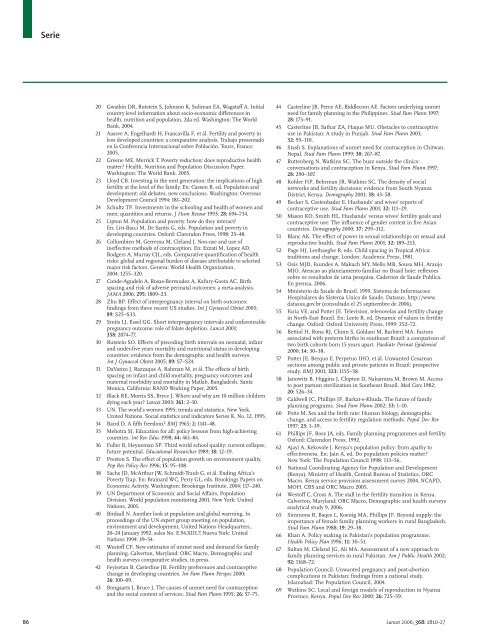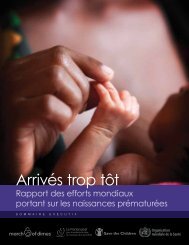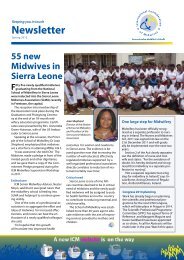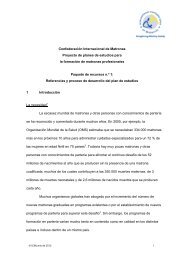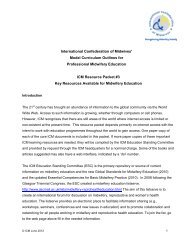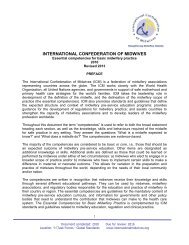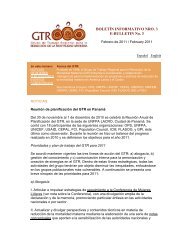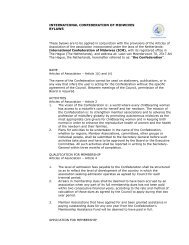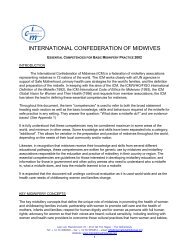Lancet - International Confederation of Midwives
Lancet - International Confederation of Midwives
Lancet - International Confederation of Midwives
Create successful ePaper yourself
Turn your PDF publications into a flip-book with our unique Google optimized e-Paper software.
Serie<br />
20 Gwatkin DR, Rutstein S, Johnson K, Suliman EA, Wagstaff A. Initial<br />
country level information about socio-economic differences in<br />
health, nutrition and population, 2da ed. Washington: The World<br />
Bank, 2004.<br />
21 Aassve A, Engelhardt H, Francavilla F, et ál. Fertility and poverty in<br />
less developed countries: a comparative analysis. Trabajo presentado<br />
en la Conferencia Internacional sobre Población. Tours, France:<br />
2005.<br />
22 Greene ME, Merrick T. Poverty reduction: does reproductive health<br />
matter? Health, Nutrition and Population Discussion Paper.<br />
Washington: The World Bank. 2005.<br />
23 Lloyd CB. Investing in the next generation: the implications <strong>of</strong> high<br />
fertility at the level <strong>of</strong> the family. En: Cassen R, ed. Population and<br />
development: old debates, new conclusions. Washington: Overseas<br />
Development Council 1994: 181–202.<br />
24 Schultz TP. Investments in the schooling and health <strong>of</strong> women and<br />
men: quantities and returns. J Hum Resour 1993; 28: 694–734.<br />
25 Lipton M. Population and poverty: how do they interact?<br />
En: Livi-Bacci M, De Santis G, eds. Population and poverty in<br />
developing countries. Oxford: Clarendon Press, 1998: 25–48.<br />
26 Collumbien M, Gerressu M, Cleland J. Non-use and use <strong>of</strong><br />
ineffective methods <strong>of</strong> contraception. En: Ezzati M, Lopez AD,<br />
Rodgers A, Murray CJL, eds. Comparative quantification <strong>of</strong> health<br />
risks: global and regional burden <strong>of</strong> disease attributable to selected<br />
major risk factors. Geneva: World Health Organization,<br />
2004: 1255–320.<br />
27 Conde-Agudelo A, Rosas-Bermudez A, Kafury-Goeta AC. Birth<br />
spacing and risk <strong>of</strong> adverse perinatal outcomes: a meta-analysis.<br />
JAMA 2006; 295: 1809–23.<br />
28 Zhu BP. Effect <strong>of</strong> interpregnancy interval on birth outcomes:<br />
findings from three recent US studies. Int J Gynaecol Obstet 2005;<br />
89: S25–S33.<br />
29 Smits LJ, Essel GG. Short interpregnancy intervals and unfavourable<br />
pregnancy outcome: role <strong>of</strong> folate depletion. <strong>Lancet</strong> 2001;<br />
358: 2074–77.<br />
30 Rutstein SO. Effects <strong>of</strong> preceding birth intervals on neonatal, infant<br />
and under-five years mortality and nutritional status in developing<br />
countries: evidence from the demographic and health surveys.<br />
Int J Gynaecol Obstet 2005; 89: S7–S24.<br />
31 DaVanzo J, Razzaque A, Rahman M, et ál. The effects <strong>of</strong> birth<br />
spacing on infant and child mortality, pregnancy outcomes and<br />
maternal morbidity and mortality in Matlab, Bangladesh. Santa<br />
Monica, California: RAND Working Paper, 2005.<br />
32 Black RE, Morris SS, Bryce J. Where and why are 10 million children<br />
dying each year? <strong>Lancet</strong> 2003; 361: 2–10.<br />
33 UN. The world’s women 1995: trends and statistics. New York,<br />
United Nations. Social statistics and indicators Series K, No. 12, 1995.<br />
34 Baird D. A fifth freedom? BMJ 1965; 2: 1141–48.<br />
35 Mehotra SJ. Education for all: policy lessons from high-achieving<br />
countries. Int Rev Educ 1998; 44: 461–84.<br />
36 Fuller B, Heyneman SP. Third world school quality: current collapse,<br />
future potential. Educational Researcher 1989; 18: 12–19.<br />
37 Preston S. The effect <strong>of</strong> population growth on environment quality.<br />
Pop Res Policy Rev 1996; 15: 95–108.<br />
38 Sachs JD, McArthur JW, Schmidt-Traub G, et ál. Ending Africa’s<br />
Poverty Trap. En: Brainard WC, Perry GL, eds. Brookings Papers on<br />
Economic Activity. Washington: Brookings Institute, 2004: 117–240.<br />
39 UN Department <strong>of</strong> Economic and Social Affairs, Population<br />
Division. World population monitoring 2001. New York: United<br />
Nations, 2001.<br />
40 Birdsall N. Another look at population and global warming. In<br />
proceedings <strong>of</strong> the UN expert group meeting on population,<br />
environment and development, United Nations Headquarters,<br />
20–24 January 1992. sales No. E.94.XIII.7. Nueva York: United<br />
Nations 1994: 39–54.<br />
41 West<strong>of</strong>f CF. New estimates <strong>of</strong> unmet need and demand for family<br />
planning. Calverton, Maryland: ORC Macro, Demographic and<br />
health surveys comparative studies, in press.<br />
42 Feyisetan B, Casterline JB. Fertility preferences and contraceptive<br />
change in developing countries. Int Fam Plann Perspec 2000;<br />
26: 100–09.<br />
43 Bongaarts J, Bruce J. The causes <strong>of</strong> unmet need for contraception<br />
and the social content <strong>of</strong> services. Stud Fam Plann 1995; 26: 57–75.<br />
44 Casterline JB, Perez AE, Biddlecom AE. Factors underlying unmet<br />
need for family planning in the Philippines. Stud Fam Plann 1997;<br />
28: 173–91.<br />
45 Casterline JB, Sathar ZA, Haque MU. Obstacles to contraceptive<br />
use in Pakistan: A study in Punjab. Stud Fam Plann 2001;<br />
32: 95–110.<br />
46 Stash S. Explanations <strong>of</strong> unmet need for contraception in Chitwan,<br />
Nepal. Stud Fam Plann 1999; 30: 267–87.<br />
47 Ruttenberg N, Watkins SC. The buzz outside the clinics:<br />
conversations and contraception in Kenya. Stud Fam Plann 1997;<br />
28: 290–307.<br />
48 Kohler HP, Behrman JR, Watkins SC. The density <strong>of</strong> social<br />
networks and fertility decisions: evidence from South Nyanza<br />
District, Kenya. Demography 2001; 38: 43–58.<br />
49 Becker S, Costenbader E. Husbands’ and wives’ reports <strong>of</strong><br />
contraceptive use. Stud Fam Plann 2001; 32: 111–29.<br />
50 Mason KO, Smith HL. Husbands’ versus wives’ fertility goals and<br />
contraceptive use: The influence <strong>of</strong> gender context in five Asian<br />
countries. Demography 2000; 37: 299–312.<br />
51 Blanc AK. The effect <strong>of</strong> power in sexual relationships on sexual and<br />
reproductive health. Stud Fam Plann 2001; 32: 189–213.<br />
52 Page HJ, Lesthaeghe R, eds. Child spacing in Tropical Africa:<br />
traditions and change. London: Academic Press, 1981.<br />
53 Osis MJD, Faundes A, Makuch MY, Mello MB, Sousa MH, Araujo<br />
MJO. Atencao ao planejamento familiar no Brasil hoje: reflexoes<br />
sobre os resultados de uma pesquisa. Cadernos de Saude Publica.<br />
En prensa, 2006.<br />
54 Ministerio da Saude do Brasil. 1999. Sistema de Informacoes<br />
Hospitalares do Sistema Unico de Saude. Datasus. http://www.<br />
datasus.gov.br (consultado el 25 septiembre de 2006).<br />
55 Faria VE, and Potter JE. Television, telenovelas and fertility change<br />
in North-East Brazil. En: Leete R, ed. Dynamic <strong>of</strong> values in fertility<br />
change. Oxford: Oxford University Press, 1999: 252–72.<br />
56 Bettiol H, Rona RJ, Chinn S, Goldani M, Barbieri MA. Factors<br />
associated with preterm births in southeast Brazil: a comparison <strong>of</strong><br />
two birth cohorts born 15 years apart. Paediatr Perinat Epidemiol<br />
2000; 14: 30–38.<br />
57 Potter JE, Berquo E, Perpetuo IHO, et ál. Unwanted Cesarean<br />
sections among public and private patients in Brazil: prospective<br />
study. BMJ 2001; 323: 1155–58.<br />
58 Janowitz B, Higgins J, Clopton D, Nakamura M, Brown M. Access<br />
to post partum sterilization in Southeast Brazil. Med Care 1982;<br />
20: 526–34.<br />
59 Caldwell JC, Phillips JF, Barkat-e-Khuda. The future <strong>of</strong> family<br />
planning programs. Stud Fam Plann 2002; 33: 1–10.<br />
60 Potts M. Sex and the birth rate: Human biology, demographic<br />
change, and access to fertility regulation methods. Popul Dev Rev<br />
1997; 23: 1–39.<br />
61 Phillips JF, Ross JA, eds. Family planning programmes and fertility.<br />
Oxford: Clarendon Press, 1992.<br />
62 Ajayi A, Kekovole J. Kenya’s population policy: from apathy to<br />
effectiveness. En: Jain A, ed. Do population policies matter?<br />
New York: The Population Council 1998: 113–56.<br />
63 National Coordinating Agency for Population and Development<br />
(Kenya), Ministry <strong>of</strong> Health, Central Bureau <strong>of</strong> Statistics, ORC<br />
Macro. Kenya service provision assessment survey 2004. NCAPD,<br />
MOH, CBS and ORC Macro 2005.<br />
64 West<strong>of</strong>f C, Cross A. The stall in the fertility transition in Kenya.<br />
Calverton, Maryland: ORC Macro. Demographic and health surveys<br />
analytical study 9, 2006.<br />
65 Simmons R, Baqee L, Koenig MA, Phillips JF. Beyond supply: the<br />
importance <strong>of</strong> female family planning workers in rural Bangladesh.<br />
Stud Fam Plann 1988; 19: 29–38.<br />
66 Khan A. Policy making in Pakistan’s population programme.<br />
Health Policy Plan 1996; 11: 30–51.<br />
67 Sultan M, Cleland JG, Ali MA. Assessment <strong>of</strong> a new approach to<br />
family planning services in rural Pakistan. Am J Public Health 2002;<br />
92: 1168–72.<br />
68 Population Council. Unwanted pregnancy and post-abortion<br />
complications in Pakistan: findings from a national study.<br />
Islamabad: The Population Council, 2004.<br />
69 Watkins SC. Local and foreign models <strong>of</strong> reproduction in Nyanza<br />
Province, Kenya. Popul Dev Rev 2000; 26: 725–59.<br />
86 <strong>Lancet</strong> 2006; 368: 1810–27


